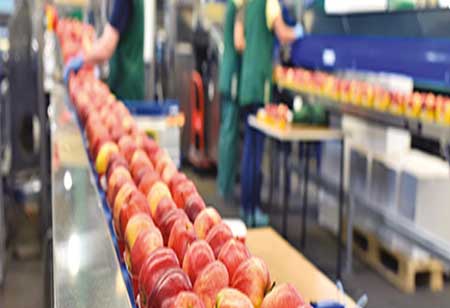THANK YOU FOR SUBSCRIBING
By Diane Corcoran, Beverage Director, Lettuce Entertain You Restaurants
Evolution in the Food and Beverage Market
By Sebastien Abbatiello, Co-CEO, Pizza Salvatore
Building Social Networks through Humor and Authenticity
By Guillaume Couture, Quality Assurance Manager, Kerry Inc
Safeguarding Quality and Safety in the World of...
By Ata (Al) Baroudi, Ph.D, Vice President, Food Safety and Quality Assurance, The Cheesecake Factory
The Unyielding Pursuit Of Excellence In Food Safety

Implementing Technological Advancements in Food Industry
Kitty Pat, Director of Quality Assurance, Bento Sushi

 Kitty Pat, Director of Quality Assurance, Bento Sushi
Kitty Pat, Director of Quality Assurance, Bento SushiThe Public Health Agency of Canada estimates that each year, 1 in 8 or 4 million Canadians are sickened by foodborne illnesses (12.5% of Canada’s overall population), with approximately 11 500 hospitalizations, and 240 deaths. The economic burden of foodborne illness outbreaks on any food company/brand can be quite devastating; this is due to lawsuits, fines, legal fees, investigations, retraining costs, and lost revenues. Companies within the food industry all process, use, and sell food in diverse ways; however, food safety compliance issues remain the same throughout. Examples of these common denominators include but are not limited to, unsafe food holding, improper cooking / reheating temperatures, unsafe food handling, improper sanitation, and lack of trained employees. An increasing number of companies around the globe today are investing in technology advancements to bridge the gap with most, if not all, aforementioned challenges in the food industry. Investments in technology can be quite costly at first, but the Return on Investment (ROI) will eventually outweigh its cost for all the advantages it brings to the table.
Bento Inc. (Bento Sushi) is North America’s second-largest sushi brand servicing a variety of business channels through 7 federally registered commissaries with prepackaged multi-day shelf-life grab & go products and 800+ locations providing “made fresh, on-site daily” prepackaged grab & go options. Food safety at Bento Sushi is paramount, and it is one of the foundations of our success. Like many other companies, we have joined the technology advancement bandwagon for accessible ways to enhance our food safety programs and safeguard our customers, consumers, and brand by serving only safe foods.
Examples of Bento Sushi’s implementation of technology advancement highlights:
Food Safety Application (Mobile App)
Conduct inspections to include photos and annotations with real-time access.
Assign and document the follow-up process from start to finish for all noted non-conformances from inspections; the system also flag/escalate when follow-ups are not completed within the required timelines.
Digitalization of food safety-related forms from the traditional pen and paper; the system allows for (1) corrective actions to be prompted if an entry or submission is outside of the required tolerance and/or (2) automation of alerts once the completed form is submitted
Real-time updates can be made to existing inspection templates and/or digitalized food safety forms
Hand scanners help verify the effectiveness of employee hand washing as the device detects for dangerous contaminants to prevent the spread of harmful illnesses.
One-stop online training platform providing training on all aspects of the business (i.e., food safety, health & safety, operations, etc.) – this allows for consistency in facilitating training content and ease of tracking employee progress/performance to ensure compliance. The system also has the capability to set up re-learning based on an established frequency or when existing training contents are revised to reflect protocol/regulation updates.
“Food safety culture starts from the top to the bottom of the organization”
Automated temperature monitoring system in real-time – this provides full visibility and ensures compliance throughout various operations. The system will flag and send out automated notifications when temperature deviations are identified for a quick turnaround on resolutions.
Automated cool-down Critical Control Point (CCP) monitoring system in real-time is crucial for compliance with our Hazard Analysis Critical Control Point (HACCP) plan. The system will flag and send out automated notifications when CCP deviations are almost failing throughout the various cool-down stages so actions can be taken before it becomes a deviation.
Technology advancement allows for overall visibility of food safety compliance at the convenience of your fingertips, and trending data can be generated in an instant. Whereas traditionally, stacks of paper will have to be shuffled through to locate historical data or spend hours manually entering historical data onto a Microsoft Excel worksheet for trending.
Freeing up time for stakeholders involved, such as front-line employees and management, will allow them to shift their focus and collaborate on what is important.
Top 5 recommendations on how to stay abreast of food safety compliance
Leverage trending on a routine basis to help pinpoint any potential gaps in your systems through the various lenses (i.e., bigger picture versus specifics) and act on it.
Maximize the capability of monitoring systems (i.e., temperature, CCP, etc.) by setting up notifications/alerts before it becomes a deviation – this will allow time to react and save all unnecessary costs.
Execute a proactive rather than reactive approach – Try to tackle the issues before they become a problem!
Establish re-training needs for employees on a set frequency and/or when training contents are updated to reflect regulation/protocol changes
Drive food safety culture with a few key points.
Food safety culture starts from the top to the bottom of the organization.
There must be management commitment and lead the team by example. Everyone has a part to play and ‘walk the walk’ rather than just ‘talk-the-talk.’
Create accountability across the entire organization, regardless of their statute.
Give reasons as to ‘WHY’ certain procedures are to be followed – it is very likely for the employees to follow and do the right thing if the reason as to why we do specific protocols / why it is important is shared.
Open communication and problem solving where employees can take part and have a voice in what they do for food safety – work together as a Team to achieve common goals
Strive for continuous improvement in established food safety programs and protocols – always look to improve on existing programs/protocols as this will only help to strengthen them.
It would be intriguing to see where technological advancement, particularly with food safety, will bring us in the next 5 to 10 years. Buckle up, folks; we’re in for the ride of our lives!!
Read Also














